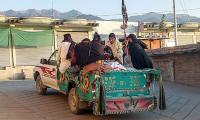CHITRAL: The abrupt changes in weather conditions in the once snowbound remote areas of the northern districts of Khyber Pakhtunkhwa have started affecting the lives of the people living there drastically, as melting glaciers have been demonstrating their devastating effects.
The persistent rise in temperature has resulted in the reduction of the huge glaciers, putting people at greater risk of glacial and lake outburst floods (GLOF). The rise in temperature can be gauged from the fact that one can now see air-conditioners installed in hotel rooms in the once cold Kalam valley, where the use of fans was previously unthinkable.
During a visit to the glacial areas of Swat, Dir, and Chitral districts, it was observed that it is difficult to stay there without a fan these days. According to the local population, temperatures increase with each passing year.
Glacial bursts have become a major concern for people living in areas adjacent to glacial routes. Mankial, Matiltan, Utroor, and Gabral in Swat districts; Kumrat in Upper Dir; and Reshun, Arkari, and Madaklasht in Chitral are a few valleys that require special mention as they are located on the routes of glacial water and have been facing the most serious threat of being washed away by floodwaters.
A major part of Reshun, a densely populated village in Upper Chitral, has already been washed away by the river and floodwaters. Soil erosion caused by both glacial and river floods has been a major concern for the local population. The village is located on the brink of the River Chitral, and the glacial channel passes through the middle of the locality. Both the river and the glacial trench erode fertile agricultural land and houses close to the river and the drain every year.
A similar situation can be witnessed in the Palogah area of Matiltan valley in Swat, which had been severely affected by the devastating floods of 2022. The Gabral area of Swat and Kumrat valley of Upper Dir were also equally affected by the floods two years ago.
In response to the escalating crisis in the areas, the United Nations Development Programme (UNDP), under its GLOF-II project, has launched a number of interventions to mitigate the effects of these floods and bolster community resilience. The UNDP’s initiatives focus on a multifaceted approach to address both immediate needs and long-term recovery.
The GLOF-II Project, officially titled “Scaling-up of Glacial Lake Outburst Flood (GLOF) Risk Reduction in Northern Pakistan,” is a vital initiative aimed at mitigating the risks associated with glacial lake outburst floods in the region. This project is part of broader efforts to enhance the resilience of communities living in glacial-prone areas, said Rashid Khan, a UNDP official.
He said that the project, funded by the Green Climate Fund (GCF) with a budget of USD 36.9 million and an additional USD 500,000 from the government of Gilgit-Baltistan, represents a commitment from both international and national stakeholders to address climate change challenges.
The GLOF-II Project, according to an official document, has positively impacted approximately 696,342 people, with an equal distribution between men and women-348,171 men and 348,171 women-in the most vulnerable areas at high risk of glacial lake outburst floods.
The project interventions have been extended to some 24 valleys in 15 districts in Khyber Pakhtunkhwa and Gilgit-Baltistan, including eight valleys in five districts of KP and 16 valleys in 10 districts of GB.
Under the project, certain targeted initiatives have been undertaken to protect the lives of people, provide safety during catastrophes, and enable them to sustain the devastation caused by floods and other disasters.
Construction of Protection Walls on the glacial routes is one of the major initiatives under the project which have protect the areas concerned against the floodwaters. A total 178 schemes of protection walls, 4,925 meters in length, benefiting 15,354 men and 14,955 women have been completed in the affected valleys of KP.
In Palogah, which had been badly devastated by the 2022 floods, the confidence of the people has been rebuilt with the construction of the protection walls on the glacial route. Displaced by the floods, the people have started returning to their native area to reconstruct their houses, shops and mosques, which had been blown away by the floods.
“I had a hotel here on the riverside, which was flattened by the gushing waters of the glacial floods in 2022. I had to move to Matiltan town. But now as the protection wall has been erected on the sides of the glacial nullah, I returned to my village and resumed my business,” said an elderly resident of Palogah.
In Kumrat valley, the protection walls have not only protected the entire population of Thall, the main town of the valley, but also the historic mosque which has been a source of great attraction for the local people as well as tourists.
In Reshun, the protection walls on the glacial nullah protected the village from devastation this year during the recent floods. According to Wazir Mohammad, general secretary of the Community-Based Disaster Risk Management Committee (CBDRMC), the glacial floods were much higher and intensive this year. The floodwaters brought with it huge boulders that might have wreaked unprecedented devastation, had the protection walls not been constructed on the nullah. One boulder shown to media persons was as huge as a five-marla piece of land.
Similar protection walls have been constructed in Shah Bagh and Bela areas of Gabral valley to divert the direction of water and thus protect the lands and houses in the area. The lands in the remotest Arkari area of Lower Chitral have also been protected against glacial floods through similar protection walls.
Also, in the flood-hit areas, irrigation channels have been constructed to benefit the local population in maintaining their agriculture, which is the main source of income in those areas. According to details, some 70 channels, 19,859 meters in length, have been constructed in the affected areas, benefiting 9,512 men and 9,262 women.
Moreover, some 61 early warning systems have also been installed in the areas to inform the population of the risk on time and avert damages.Tree plantations have been made on large pieces of lands in the Reshun area of Chitral and Gabral in Swat to overcome soil erosion and reduce the risks of climate change.
Community centres and safe heavens have also been constructed in all the affected areas to provide protection to the people in the time of need and impart them necessary training from time to time.
A view of thick fog that engulfs the whole city during morning time in the Federal Capital on January 2, 2024. —...
Rehan Naseem Bharara, President Faisalabad Chamber of Commerce and Industry addressing special meeting of executive...
A representational image of a robbery at gunpoint. — APP/FileTAKHTBHAI: Around six armed robbers broke into a house...
The Khyber Pakhtunkhwa Revenue Authority building seen in this image.— Facebook@kpraOfficial/FilePESHAWAR: The...
Deputy Inspector General of Police, Hazara Range, Nasir Mehmood Satti. — Facebook@KPKPolice/File MANSEHRA: Urging...
The residents of Parachinar staged a protest against the Kohat firing incidents on June 21, 2024. —...







